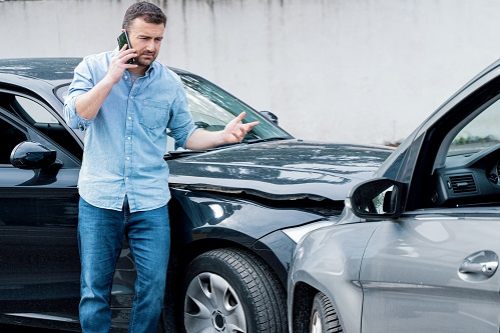Is your new car already insured?
If you are already insured, your current car insurance company typically will cover you for a short time, which varies from company to company, until you can call with the details on the new car. In this case, you'll need to transfer or add insurance to your new car.
You'll usually have the same coverage on the new car that you did on the old.
If you had only liability coverage on the trade-in, you'll have only liability coverage on the new ride. That means if your old car was paid off and your new one isn't, you'll need to add the collision and comprehensive insurance lenders require before leaving the dealership.
Buying insurance while at the dealership
If you don't already have a car insurance policy, you will need to buy coverage before you leave the dealership with your new car.
Contact more than one agent or compare car insurance rates online. If you are currently not insured, you'll probably find that some companies are reluctant to cover you, and the quotes you get from the companies that will cover you can differ by hundreds, if not thousands, of dollars a year.
You will need to put a down payment on your new insurance coverage.
Even if you are insured, a new car is a great time to revisit what your current coverage amounts or compare quotes again. You don't want all the savings you just negotiated in the finance office to go up in smoke when you buy insurance.
What coverage should I buy?
If financing the vehicle, the lender will require that you have full coverage -- that is, comprehensive and collision coverages that protect the vehicle itself against accidents, theft and vandalism. Your insurance company will need to submit proof of coverage to the lender, usually within a few weeks of the purchase. If they don't get that evidence, they may buy very expensive coverage of their own and bill you for it.
You should also be certain that you have sufficient liability coverage to protect your assets from personal injury or property damage claims that may arise from an auto accident. If you own a house or have any savings, it's unlikely that minimum liability coverage will be enough. Use our auto insurance coverage calculator to get an idea about what level of liability coverage to buy.
And if you didn't put at least 20% down on the car or are financing for more than 60 months, consider gap insurance.
If you're leasing the vehicle, be sure to check your lease contract for any minimum coverage limits. Most leases require that you carry a minimum liability coverage limit or else you'll be in violation of the lease, and many require higher liability limits that state minimums. Leasing companies may limit how high you can raise your deductibleThe deductible is the amount you pay out of pocket for a covered loss when you file a claim. as well.
If buying the car outright, you can go as low as state minimum requirements, and you do not need to buy physical damage coverage such as collision if you decide it's not worth the cost.
Auto insurance policies: What's covered?
A personal auto policy is a contract between you and your insurer. Essentially, your insurer promises to provide coverage up to a specified limit in return for your payment of a premiumThe payment required for an insurance policy to remain in force. Auto insurance premiums are quoted for either 6-month or annual policy periods.. Typically you have the option of four types of insurance coverage:
Liability coverage: Liability coverage insures you against injuries you cause to other people (bodily injury coverage) and other property (property damage coverage) in an auto accident, up to a specified limit. Since liability claims for pain and suffering can be very costly, this is one area in which you do not want to be underinsured.
Medical payments coverage: Medical payments coverageAn auto insurance coverage that provides coverage for medical expenses incurred by you and your passengers in the event of an accident, regardless of who is at fault. pays medical expenses up to a specified limit resulting from an auto accident, without regard to fault. This coverage is required in some states and optional in others.
Uninsured/underinsured motorist coverage: Uninsured motorist coverage insures you against losses caused by a driver who is uninsured or has less than adequate insurance to cover the loss.
Coverage for damage to your auto: This coverage consists of two parts, collision and comprehensive. Collision insures the value of your car in the event of an accident, while comprehensive protects you against other types of damage to your car (such as theft, fire and vandalism). These coverages include a deductible, which is the amount of a claimAn insurance claim is a request you make to your insurance company for coverage after your car is damaged or you have an accident. You can file a claim online, by phone, or in writing. you agree to pay per incident.



